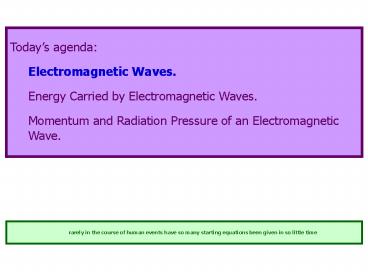Today PowerPoint PPT Presentation
Title: Today
1
Todays agenda Electromagnetic Waves. Energy
Carried by Electromagnetic Waves. Momentum and
Radiation Pressure of an Electromagnetic Wave.
rarely in the course of human events have so
many starting equations been given in so little
time
2
We began this course by studying fields that
didnt vary with timethe electric field due to
static charges, and the magnetic field due to a
constant current. In case you didnt
noticeabout a half dozen lectures ago things
started moving!
We found that changing magnetic field gives rise
to an electric field. Also a changing electric
field gives rise to a magnetic field.
These time-varying electric and magnetic fields
can propagate through space.
3
Electromagnetic Waves
Maxwells Equations
These four equations provide a complete
description of electromagnetism.
4
Production of Electromagnetic Waves
Apply a sinusoidal voltage to an antenna.
Charged particles in the antenna oscillate
sinusoidally.
The accelerated charges produce sinusoidally
varying electric and magnetic fields, which
extend throughout space.
The fields do not instantaneously permeate all
space, but propagate at the speed of light.
y
direction of propagation
x
z
5
y
direction of propagation
x
z
This static image doesnt show how the wave
propagates.
Here are animations, available on-line
http//phet.colorado.edu/en/simulation/radio-waves
(shows electric field only)
http//www.phy.ntnu.edu.tw/ntnujava/index.php?topi
c35
Here is a movie.
6
Electromagnetic waves are transverse waves, but
are not mechanical waves (they need no medium to
vibrate in).
Therefore, electromagnetic waves can propagate in
free space.
At any point, the magnitudes of E and B (of the
wave shown) depend only upon x and t, and not on
y or z. A collection of such waves is called a
plane wave.
y
direction of propagation
x
z
7
Manipulation of Maxwells equations leads to the
following plane wave equations for E and B
Equations on this slide are for waves propagating
along x-direction.
These equations have solutions
Emax and Bmax are the electric and magnetic field
amplitudes
where
You can verify this by direct substitution.
Emax and Bmax in these notes are sometimes
written by others as E0 and B0.
8
You can also show that
At every instant, the ratio of the magnitude of
the electric field to the magnitude of the
magnetic field in an electromagnetic wave equals
the speed of light.
9
y
direction of propagation
x
z
Emax (amplitude)
E(x,t)
Nit-picking detail Ex is the x-component of the
electric field vector. It has both a magnitude
and a direction. E is the magnitude of the
electric field vector, and because for this wave
the electric field has only an x-component, E ?
Ex ?. I may get careless in class and refer to Ex
as the magnitude of E, when I should really
include the absolute values ? Ex ?.

